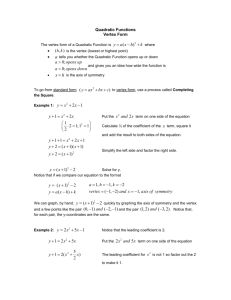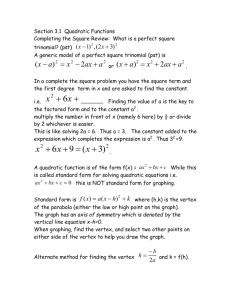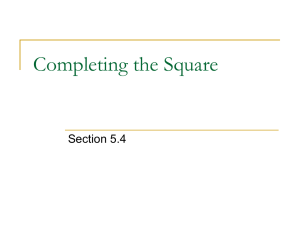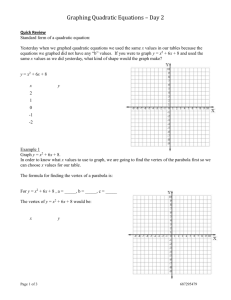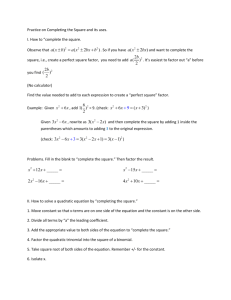Sketch a graph of the quadratic function
advertisement
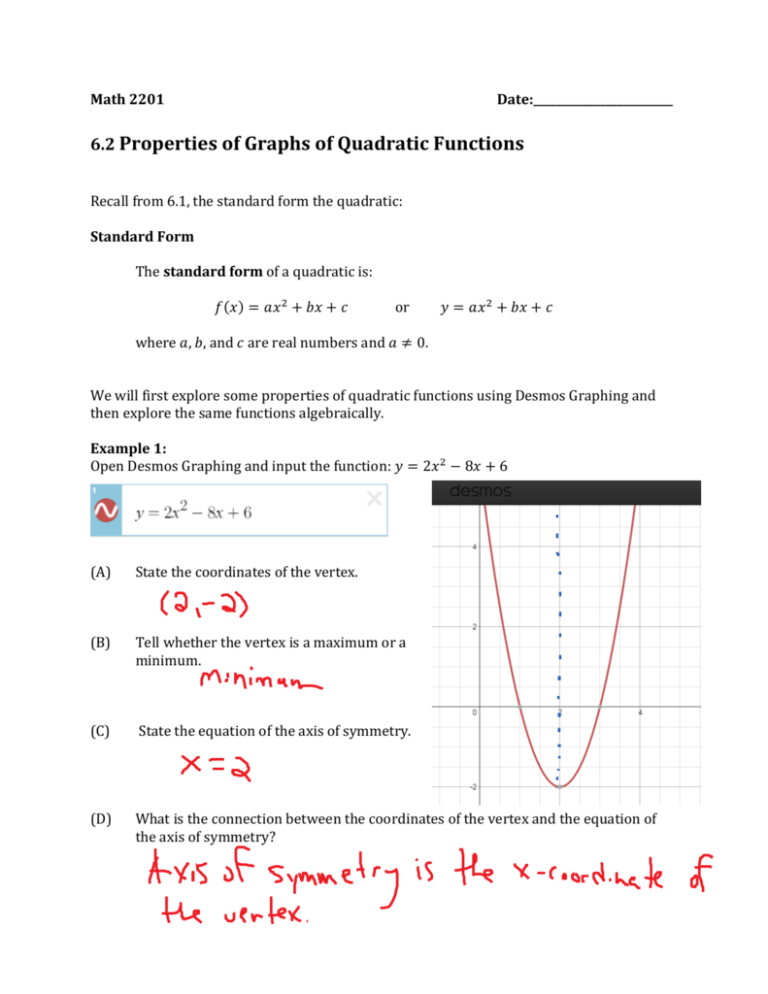
Math 2201
Date:_________________________
6.2 Properties of Graphs of Quadratic Functions
Recall from 6.1, the standard form the quadratic:
Standard Form
The standard form of a quadratic is:
𝑓(𝑥) = 𝑎𝑥 2 + 𝑏𝑥 + 𝑐
or
𝑦 = 𝑎𝑥 2 + 𝑏𝑥 + 𝑐
where 𝑎, 𝑏, and 𝑐 are real numbers and 𝑎 ≠ 0.
We will first explore some properties of quadratic functions using Desmos Graphing and
then explore the same functions algebraically.
Example 1:
Open Desmos Graphing and input the function: 𝑦 = 2𝑥 2 − 8𝑥 + 6
(A)
State the coordinates of the vertex.
(B)
Tell whether the vertex is a maximum or a
minimum.
(C)
State the equation of the axis of symmetry.
(D)
What is the connection between the coordinates of the vertex and the equation of
the axis of symmetry?
When we are given a table of values, in which the vertex is included in the table, we can
determine the coordinates of the vertex. Find two points that have the same 𝑦-coordinate
then go to the point whose 𝑦-coordinate falls right in the middle of these two. This point
will be the vertex.
Example 2:
Observe the table of values for a quadratic function.
(A)
Based on the table, determine whether the parabola will have a maximum or a
minimum point.
(B)
Determine the coordinates of the vertex.
(C)
Determine the equation of the axis of symmetry.
Relating the Vertex and Axis of Symmetry to the 𝒙-intercepts of a Parabola
Example 3:
Consider the parabola shown:
(A)
Determine the axis of symmetry.
(B)
Determine the vertex.
When we know the coordinates of the 𝑥-intercepts of a parabola, we can get the
𝑥-coordinate of the equation of the axis of symmetry and the vertex and by taking the
average of the 𝑥-intercepts.
Example 4:
The equation of the axis of symmetry of a quadratic function is 𝑥 = 4. The minimum
𝑦-value of the parabola is 3. What is the vertex of the parabola?
Finding the Axis of Symmetry and Vertex Algebraically from Standard Form
The 𝑥-coordinate of the vertex can be determined using the formula:
𝑥=−
𝑏
2𝑎
To determine the y-coordinate of the vertex, substitute the 𝑥-value into the quadratic
equation and solve for 𝑦.
Let’s use the quadratic equation we explored with Desmos Graphing:
Example 5:
(A)
Find the vertex of 𝑦 = 2𝑥 2 − 8𝑥 + 6.
(B)
What is the axis of symmetry?
Example 6:
Identify the values of a, b and c along with the value of −
𝑏
2𝑎
Zero Product Property
You can also use the following techniques to help them determine the equation of the axis
of symmetry of non-factorable quadratic functions. The zero product property will now be
introduced, but a more detailed discussion will occur in the next unit.
Let’s use an example to demonstrate. Consider 𝑦 = 2𝑥 2 − 4𝑥 + 7. It isn’t factorable, but a
vertical translation of −7 would produce a function of 𝑦 = 2𝑥 2 − 4𝑥, which is factorable.
Since a vertical translation has no effect on the axis of symmetry, both of these functions
would have the same axis of symmetry.
𝑦 = 2𝑥 2 − 4𝑥
Now consider:
𝑦 = 2𝑥 2 − 4𝑥 + 7
The equation of the axis of symmetry is located half way between 0 and 2. The equation of
the axis of symmetry, therefore, is 𝑥 = 1. When using this method, you are not determining
𝑥-intercepts here as they would if they were factoring the quadratic function.
Sketching Graphs of Quadratics from Standard Form
To graph the quadratic function, we will determine two points on the graph. Namely the
𝑦-intercept and vertex.
Steps:
Determine the 𝑦-intercept.
Determine the coordinates of the vertex.
Plot the 𝑦-intercept and vertex.
Use symmetry to plot another point opposite the 𝑦-intercept.
Sketch a parabola using these three points.
Example 7:
Sketch a graph of the quadratic function 𝑦 = 𝑥 2 − 2𝑥 − 1
Domain and Range of a Quadratic Function
Domain: refers to all possible 𝑥-values
Range: refers to all possible 𝑦-values
Domain: {𝑥|𝑥 ∈ 𝑅} - this is true for all quadratics we deal with.
Range: depends on
i.
direction of opening and
ii.
the 𝑦-coordinate of the vertex
The number included within the range is the 𝑦-coordinate of the vertex. The inequality sign
depends on the direction of opening of the parabola.
{ 𝑦|𝑦 ≥ 𝑦-coordinate of vertex, 𝑦 ∈ 𝑅} - if the parabola opens upward/we have a
minimum
{ 𝑦|𝑦 ≤ 𝑦-coordinate of vertex, 𝑦 ∈ 𝑅} - if the parabola opens downward/we have a
maximum
Example 8:
State the domain and range for each graph shown.
(A)
(B)
Your turn:
1. Determine the vertex of each of the following:
(A)
(B)
(C)
𝑦 = 2𝑥 2 − 8𝑥 + 7
2. Using the Zero Product Property, find the axis of symmetry of 𝑦 = 3𝑥 2 + 6𝑥 − 5.
3.
Given the graph of 𝑦 = −2𝑥 2 + 8𝑥 − 3, ask the following interview questions:
(A) What is the value of the 𝑦-intercept?
(B) What is the direction of opening?
(C) What is the vertex?
(D) What is the equation of the axis of symmetry?
(E) What is the connection between the axis of symmetry and the vertex?
Textbook Questions: page 333, 334, #3, 4, 5, 6, 8, 9a,b, 10, 11

